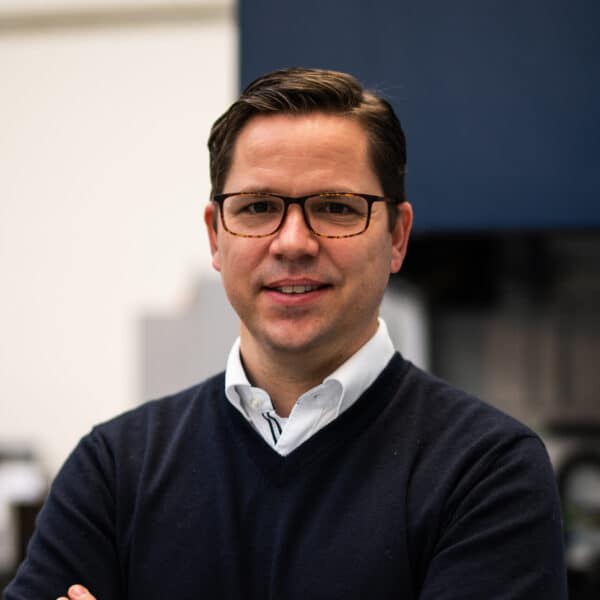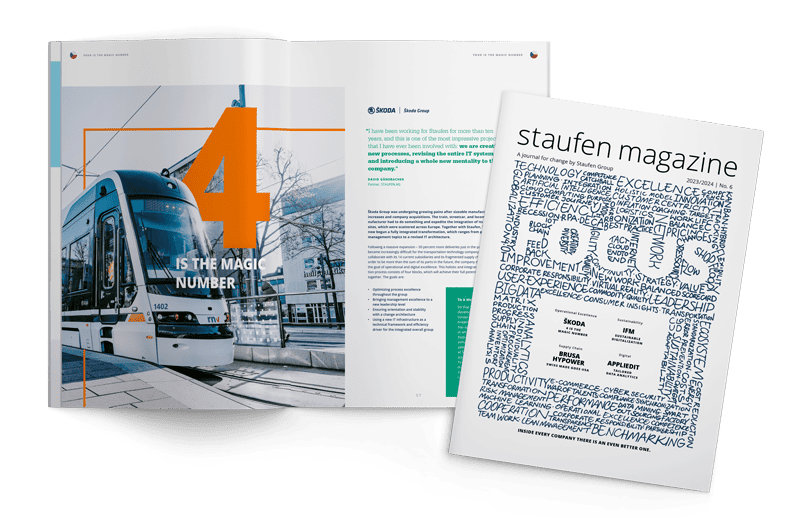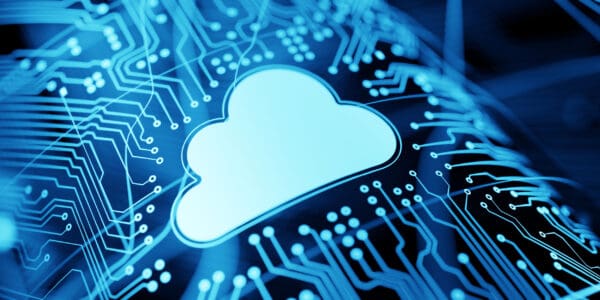
They talk a lot about Industry 4.0, but the smart factory is still far in the future for most companies. In its Customer Center in the headquarter at Ditzingen, the Machine tool and laser technology specialist Trumpf offers a preview towards the industrial future. In an interview, Alexander Kunz, the Customer Center manager, points out which parts have already become reality at TRUMPF.
Mr. Kunz, the TRUMPF Customer Center is a regular contact point for the Staufen BestPractice Tour. What is TRUMPF showing to the visitors there and how do you achieve the greatest wow effect?
Kunz: Our customer center is a real smart factory. We are working there with machines for sheet metal production and thus offer visitors an authentic experience. However, the wow effect is generated less by what we do there, but more by showing how we do it. Because the visitors experience that a smart factory works regardless of how automated the material flow is, i.e. how many robots are set up. Rather, it depends on lean processes and smart control.
How do you introduce TRUMPF to the visitors there – still as a classic mechanical engineering company?
Kunz: No, because that’s not TRUMPF anymore. Rather, we are a modern digital company that deals with cross-process, holistic solutions. There are now more employees in our development department who deal with software, processes and digital business models than those who are still working on classic hardware. Visitors to the Customer Center can also see how we have changed by the use of partner products that are deliberately not branded as TRUMPF products.

Alexander Kunz
Head of Customer Center
TRUMPF Werkzeugmaschinen SE + Co. KG

What is the central driver for TRUMPF to develop digital business models?
Kunz: Clearly it’s the customers. Thanks to digitization, we now have much more transparency about their needs. That’s why we want to offer them solutions that go beyond pure production, that help them do their business and, above all, prevent the machine from standing still. Because that’s always the most expensive thing.
What new business models has TRUMPF developed in the past few years?
Kunz: For example, the “Oseon” software, which customers can use to control their production and material flow. This software can be expanded in the areas of warehousing, logistics and interfaces – up to the complete networking of the company. Or “pay-per-part”, the use of the machine as a service, where customers only pay for the manufactured parts. TRUMPF takes over remote production planning and control as well as machine programming and maintenance.
In addition to digitization, sustainability is currently at the top of the agenda for many companies. How does TRUMPF connect these two topics?
Kunz: At this year’s Intech, we presented the newly founded company “Scrap2Value”, in which TRUMPF is also a stakeholder. Here, we let ourselves be guided by the idea of sustainability and developed a solution for more intelligent scrap recycling. Because if the scrap is sorted correctly, it can be processed in a much more climate-neutral manner, which in turn influences the company’s greenhouse gas balance. By the right sorting, we can address up to 40 percent of our CO2 footprint. And by linking it to “Oseon”, the solution becomes even smarter and gains additional value for the customer.
Although many companies are dealing intensively with digitization, the most recent Staufen study also shows that in many places, the transformation is progressing slowly. What does TRUMPF do better or differently?
Kunz: Also for us, the transformation was very strenuous and is far from over. I would state that if Industry 4.0 is the goal, we’ve already reached 3.8. The clear positioning as a board department helped us with the change project. Mr. Kammüller, our stakeholder, took on the CDO role and drove the entire change forward.
If you look into the future: Where will TRUMPF stand in 2030? And where will your industry be?
Kunz: We are expecting the trend towards sustainability to lead to growth in sheet metal processing. Many components are still “milled from the solid”. Against the background of necessary energy savings and the European Green Deal and the associated CO2 prices, this will no longer be worthwhile for every application. Therefore, many will rely on alternative construction methods with sheet metal. The trend towards networking will also continue, not only within the factory, but also across entire plants. As a result, significantly fewer machines will be required and capacity utilization will increase. Due to the shortage of skilled workers, the demand for automation solutions will increase. TRUMPF therefore relies on individual consulting solutions and tailor-made overall solutions for our customers.
The company
The TRUMPF Group is one of the global market and technology leaders in machine tools and lasers for industrial production. Software solutions should pave the way for customers to the smart factory. The company recently achieved sales of more than 4.2 billion euros with around 16,500 employees.
16.500
employees
4,2
billion euros sales
Request the English Magazine now as a digital or print version

THIS MIGHT ALSO INTEREST YOU

SEW expert talk – Digitalization in intralogistics
Automation in intralogistics is an unstoppable force. Jens Kohlhaas, lean expert at SEW-EURODRIVE, and his colleague Gero Bockelmann, Manager System Planning MAXOLUTION®, are convinced of this. Together with Federica Kraft, project manager at Staufen AG, they explain how factory automation goes from a vision to an operative success.
Read more
Unleashing Operational Performance through Tailored Data Analytics
Company data is still the most underused asset. In the labyrinth of industry operations, where data flows are as complex as they are copious, AppliediT stands out, a Spain based technological beacon illuminating the path to improved operational performance by using tailored data analytics solutions and data engineering services.
Read more
数字化 & 工业4.0
为了通过工业4.0的智能生产流程实现更高的生产力和效率,为了更快更有针对性地满足个人客户的愿望,或者为了开发全新的工业产品和商业模式,它们都是不可或缺的先决条件。尤其是中小型企业特别需要这方面的支持和咨询意见。
Read more


